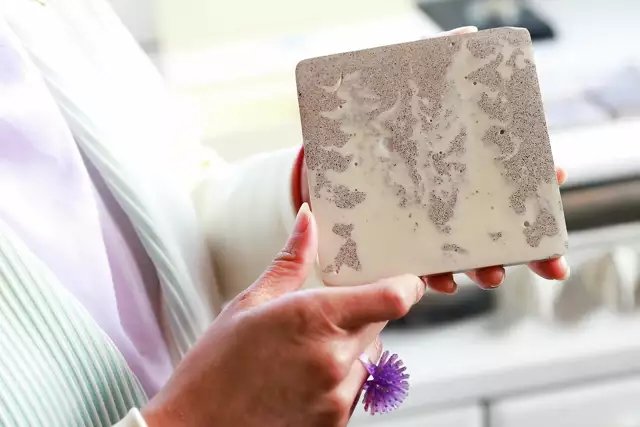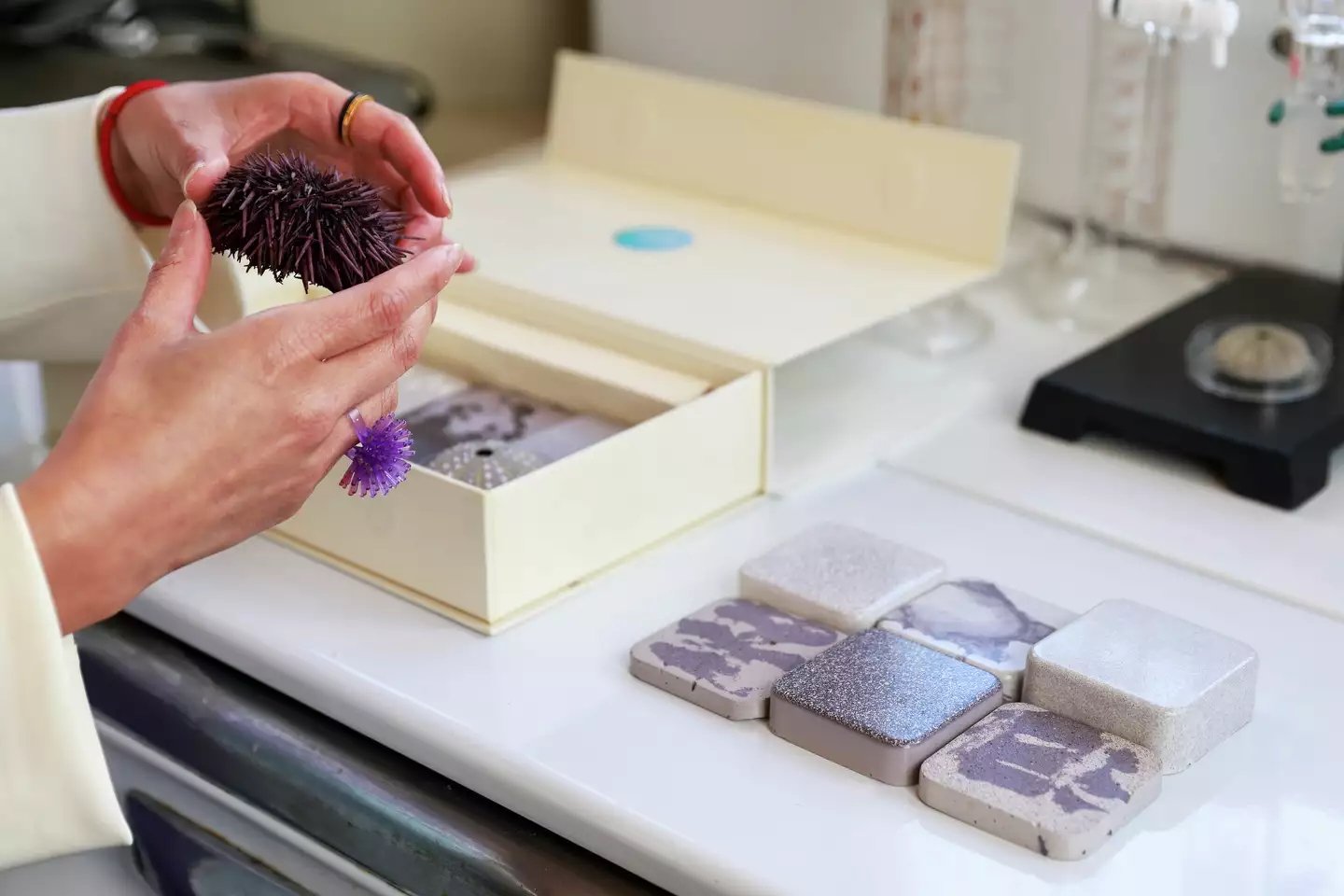Kelp rests on the rocks during low tide, left, along the coast in Sea Ranch in Mendocino County. Kelp forests along the Northern California coast have nearly disappeared, leaving the seafloor covered in urchins, such as the one seen at right.
Jessica Christian/S.F. Chronicle
By Olivia Cruz Mayeda, SF Chronicle
Joe Lee surfaced from Mendocino Bay grasping a pearl. It was the 1800s, and a lush forest of kelp swayed beneath him, home to sea urchins and abalone — one of which had transformed a bit of grit into the treasure he held in his hand.
That pearl is still in Lee’s family, and looks much the same as it did more than a century ago. But the kelp forests along the Northern California coast have, of course, nearly disappeared, leaving the seafloor covered in purple urchins in an unprecedented devastation of an ecosystem, and the adjacent fishing industry. The Asian American communities that once thrived off those kelp forests have also changed, searching for new ways to live off the ocean that has sustained them for more than a century.
When Lee found his pearl in the 1880s, he also built a wooden temple to Kwan Tai, the Taoist god of abundance, integrity and longevity. It sits in what used to be Mendocino’s Chinatown, facing south toward the inlet where Big River flows into Mendocino Bay.
Earlier this year, Lee’s great-granddaughter, Lorraine Hee-Chorley, 72, opened the temple doors, which students in the community’s Chinese New Year parade still enter to receive traditional blessings. Hot sunlight flooded onto an altar adorned with offerings of citrus, which looked out on the ocean where Hee-Chorley’s family foraged for abalone and pearlescent shells that they would sell to tourists in town.
“In this bay, there used to be tons of bull kelp,” Hee-Chorley said, looking out onto the water from the temple’s porch. “But it’s not there. It’s just not there.”
Local historian and Chinese fisherman descendant Lorraine Hee-Chorley, left, opens the doors of the Temple of Kwan Tai, built by her great-grandfather in 1854 in Mendocino. A picture from the late 1800s, right, shows Hee-Chorley’s great-grandfather Joe Lee and her grandmother Yip Lee.
Photos by Jessica Christian/S.F. Chronicle
In its stead are blankets of those spiky purple urchins covering the seafloor. But now, a Bay Area scientist believes she’s found a way to turn the scourge of these urchins into a profit point by using them as literal building blocks. And some of the people working with her are the Asian American fishermen who have spent decades making a living off of the ocean.
In January, Mickey Kitahara swayed with the morning tide at the bottom of the Albion Cove, about 10 miles south of where Lee found his pearl in the 1880s. He returns to this spot every month to remove purple urchins encroaching on vulnerable kelp fronds with his bare hands. He knows it’s an uphill battle, but he feels he has to do his part to rehabilitate the Northern California coastline — while also supporting his family.
“Those purples in here, they just consume every inch they can, stacked right next to each other on a reef, and don’t leave room for anything else,” he said.
A month later, Mickey, 42, and his father Mike, 75, stood on a metal dock in Albion, tending to their urchining equipment. On either side of the brawny duo were white boats with blue trim. At the bow of Mickey’s boat, a yellow hose encircled itself like a snake.
Mickey Kitahara on his boat, which he uses for sea urchin diving. In the early 20th century, Kitahara’s great-grandparents were part of a thriving abalone fishery built by Japanese immigrants.
Jessica Christian/S.F. Chronicle
About 35 years ago, roughly the lifespan of an abalone, a 6-year-old Mickey was learning to breathe through a hose just like it in the hot tub outside his Japanese American family’s house in Albion. That was when Mike was making more than $100,000 a year diving off the side of his boat for urchins and abalone. He was carrying on a family legacy that began in Monterey’s fishery, where his grandmother, Takako Kitahara, had shucked abalone on Cannery Row — and lost one of her fingertips to a blade. He passed that legacy to Mickey by gifting him a boat on his son’s 22nd birthday. It was one of about 40 that filled the Albion estuary at the time.
Mike Kitahara participates in a sea urchin harvest, left, in San Diego in 1977. Kitahara’s wife Susy, right, holds large sea urchins during a dive near Santa Rosa Island, off the coast of Santa Barbara, in 1977.
Photos courtesy of Mike Kitahara
On a gray morning in 2015, Mickey was christening his new urchin fishing license alongside his dad. “Oh man, you’re in for it,” he remembered a diver on a passing boat saying as Mickey cracked open his first catch of the day to find the shells, once plump and egg yolk-orange with roe, empty.
“The quality got so bad you couldn’t sell ’em,” Mike said, looking on as Mickey stepped onto his boat.
Since Mike began diving for urchins in the ’70s, the number of commercial divers in the area has shrunk 90%, he said. The number of urchin processors in Fort Bragg, which used to employ around 30 people each, has halved. Today, the estuary where Mike and Mickey dock their boats sees only around a dozen on a busy day.
“It’s sad to see that a lot of these boats that have been passed down for generations go into disrepair or get scrapped,” Mickey said. “Maybe it belonged to somebody’s grandfather that was passed down to his son and passed down to his son.”
LEFT: Divers Mickey Kitahara, right, and his father, Mike Kitahara, with boats they use to dive for sea urchins. RIGHT: Their latest docking area is on the Albion River in Mendocino County.
Photos by Jessica Christian/S.F. Chronicle
In the early 20th century, Mickey’s great-grandparents were part of a thriving abalone fishery built by Japanese immigrants like them. Before the U.S. government incarcerated the Kitaharas’ ancestors and 120,000 other Japanese people during WWII, they made up a large chunk of California’s fishing community, including 80% of the fishermen in Monterey, said anthropologist Sandy Lydon. When they returned, the state had seized their boats and barred all “Japanese aliens” from receiving fishing licenses, which they later reinstated. The Japanese community never recovered. Mickey’s great-grandfather, who had previously sold fishing nets, became a gardener.
Eighty years later, Mickey was doing a bit of underwater gardening, filling his nets with unmarketable urchins. He looked at his watch, which counted down the minutes to when he would surface for a break from loading urchins into his basket. Bare, whitewashed rock and droves of zombified urchin husks surrounded him on the seafloor. But in the areas Mickey has been clearing for the past four years, a few patches of kelp stalks fanned out into fronds at the surface.
Since 2021, local kelp restoration projects like the Waterman’s Alliance, Reef Check and the Nature Conservancy have relied on divers like Mickey to do an inverted version of what he was raised to do: collect urchins and then throw them away like piles of dry leaves.
Near the Albion River Bridge in Mendocino County is a kelp restoration project run by the Nature Conservancy.
Jessica Christian/S.F. Chronicle
“The idea is to get these areas to grow kelp, and then as the spores are released we can clear the area to allow for the kelp to grow without as much pressure from those purple urchins,” he said. Still, it was meditative, “like raking leaves in your yard.”
Now, kelp restoration, too, is under threat.
In February, the National Oceanic and Atmospheric Administration for Pacific Ocean restoration fired more than 1,000 employees and is slated to close three of its California offices, including ones dedicated to marine protection and fisheries. NOAA helps fund the projects that hire Mickey, so losing that support is a “real fear,” he said as bouquets of kelp bobbed on the bay.
“If it would not be enough to survive, I would need to switch things up and go find a different avenue to bring in some income,” he said.
The luster of Joe Lee’s pearl, the protective spikes of the urchins collected by Mickey Katahara and even the bone of Takako Kitathara’s severed fingertip have something in common: Each contains calcium carbonate. The substance is also the main component of marble, which is how Virj Kan hopes to help the kelp forest and a Northern California community built on the ocean.
Two years ago, Kan was in Mendocino after earning her masters from the Massachusetts Institute of Technology in biomaterials, hoping she could lend her science background to the kelp crisis. While there she met up with a burly, tanned man outside an urchin processing plant in Fort Bragg who had just culled 400 pounds of purple urchins, which he loaded off his truck in buckets and barrels. It was Mickey Kitahara. Usually, he dumps them into a large bin, which might be repurposed into fertilizer or may just sit there indefinitely, he said. This time, he handed them off to Kan, a scientist.
Scientist and artist Virj Kan in her research residency and lab in Berkeley, where she creates marble from sea urchins. As California kelp disappears, Kan is working with divers to create an economic incentive for culling overpopulated sea urchins from Mendocino. Right, Kan holds a marble tile she created.
Photos by Jessica Christian/S.F. Chronicle
Virj Kan holds a sea urchin in her Berkeley lab. Kan creates marble from urchins, the sales of which she hopes will increase demand for urchin removal and kelp restoration.
Jessica Christian/S.F. Chronicle
“She was going to make tiles or something,” Mickey remembered.
In March, an urchin husk sat on the counter of Kan’s home in Berkeley, a Victorian mansion built for a sea captain now owned by Stochastic Labs, a nonprofit that incubates entrepreneurs. Beakers and flasks perched on a gas stove behind Kan as she held up a small tile variegated with shades of dark and light purple.
“There’s a lot of people studying the kelp forest, a lot of people that are helping to remove the urchins to bring the kelp back, but there’s a missing link, which is, ‘What’s the market?’” she said.
In April, Kan launched Urchinite, a marble synthesized from pulverized, calcium carbonate-rich urchins, whose sales she hopes will increase demand for urchin removal and kelp restoration.
An Urchinite countertop measuring 40 square feet — and costing between $1,600 to $7,200, depending on its design — would restore 0.06 of an acre of seafloor, Kan said.
The 12 acres within the Nature Conservancy’s purview in Mendocino would translate to roughly 200 countertops.
Kelp rests on the rocks during low tide along the coast of Sea Ranch in Mendocino County in February.
Jessica Christian/S.F. Chronicle
Back in Mendocino in May, Mickey looked at the renderings of Urchinite countertops and tables on his phone.
“I could see myself interested in a countertop,” he said. “That would be beautiful.”
Mickey was feeling more optimistic than usual. Tomatoes were growing in his yard and bits of baby kelp were appearing out on the ocean in little balls Mickey calls “lollipops.”
“It is a hopeful time of year,” he said.
At least once a day, though, Mickey thinks about “Plan B”: what he’ll do if the fisheries don’t come back, funding dries up and efforts like Kan’s don’t pan out enough to keep him diving.
“Some of the guys that have been doing it as long as my dad say the urchin industry is over,” he said. “I honestly don’t know.”













